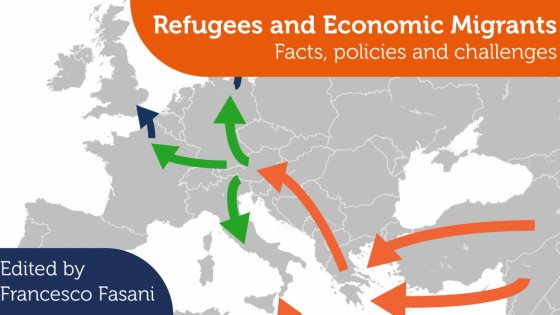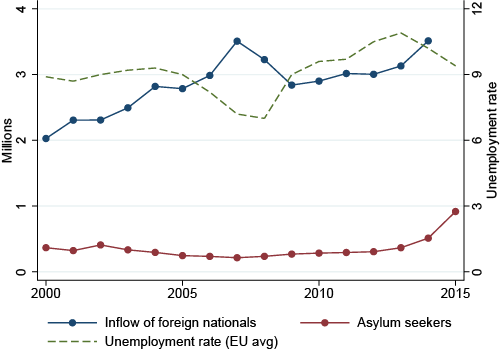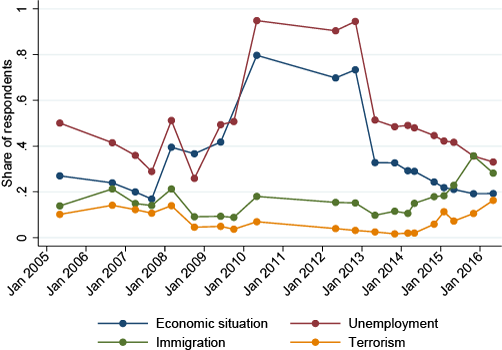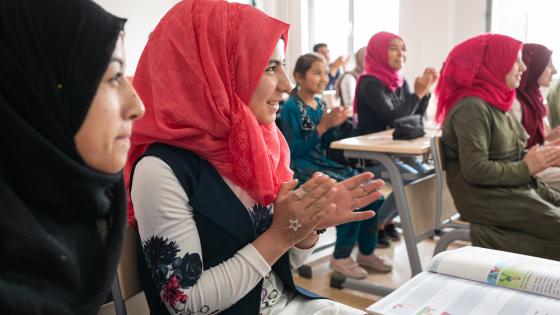The media and political attention that migration issues receive goes through cycles. European countries are currently going through the peak of a cycle. In the last few years, news stories about refugees from Asia and Africa have become a constant feature of all major European media outlets. The political repercussions of hosting – or of refusing to host – refugees are also highly debated in several European countries (Dustmann et al. 2016). Immigration took centre stage in the campaign that led to the vote for ‘Brexit’ of the UK from the EU in June 2016 (Portes 2016). Beyond Europe, immigration – and undocumented migration, in particular – is an extremely divisive issue in the US political debate, as it has been well represented in the latest presidential run.
A new VoxEU eBook offers a brief summary of what economists have learnt about migration in several crucial areas of policymaking, and identifies most of the important questions that still remain to be answered (Fasani 2016).
Download using the following link:
Two concurring factors have arguably contributed to bringing migration to the centre of public attention. First, the aftermath of the Great Recession, with weaker economic prospects and generalised cuts to public spending, led voters to question progressively more the legitimacy of foreign nationals’ presence in their countries. Fears of potential competition in accessing the labour market and the welfare state naturally intensify when opportunities shrink, especially when some politicians actively work to exaggerate such concerns. The second element has been the ongoing refugee crisis. It is up for debate whether a cohesive and solid EU would face serious constraints in effectively welcoming and integrating such an inflow of refugees. It is clear, however, that the European institutions are struggling and are revealing all of their fragilities. While member countries are engaging in autonomous and uncoordinated responses, concern and hostile feelings seem to be on the rise among the general public.
Economic migrants and refugees in Europe
The recent immigration experience in Europe is summarised Figure 1, which combines OECD estimates on annual inflows of foreign nationals to EU countries, Norway and Switzerland (‘EU+NOR+CHE’) with records from the UN High Commissioner for Refugees (UNHCR) on asylum applications and Eurostat data on the average unemployment rate in the EU.
Sustained inflows of foreign nationals (blue line in the graph) were recorded in all European countries in the 2000s. The total annual inflow of immigrants steadily increased from about 2 to 3.5 million between 2000 and 2007. This upward trend was reversed in the following two years – new entrants dropped to 2.8 million in 2009 and then stabilised at around 3 million per year until 2013. The inflow then reached 3.5 million again in 2014. Note that all these figures include both inflows from non-EU countries and movements of EU citizens from one EU country to another. As expected from economic migrants, fluctuations in the arrivals of foreign workers closely followed the economic cycle of European economies. The average EU unemployment rate over the period is displayed by the dashed line in Figure 1. Increasing inflows of immigrant workers were recorded in years of declining unemployment rates in European countries (from 9% to 7% between 2000 and 2008). The arrival of the Great Recession, however, led the average unemployment rate to a peak of almost 11% in 2013. Inflows of migrants declined in response to the worsening of economic opportunities in Europe. Economic recovery finally lowered the average unemployment rate to 9.4% in 2015, and the annual intake of immigrants started increasing again.
Inflows of asylum seekers to Europe are illustrated by the red line in Figure 1. The number of asylum applications filed in European countries remained fairly flat at around 200-300,000 individuals per year for most of the period, showing no visible response to the onset and spread of the economic crisis across European economies. The numbers started growing only in 2013, when UNHCR recorded 360,000 asylum applications submitted in EU+NOR+CHE countries. In 2014 the figure was above 500,000, and in 2015 it reached more than 900,000 applications. The timing of this ‘refugee crisis’ was determined by dramatic political events that took place outside Europe and was truly unfortunate for the victims of displacement, whose arrival in Europe was met with political disagreement at the EU level and often with opportunistic behaviour at the individual country level.
Figure 1 Inflow of foreign nationals, asylum seekers and unemployment rate in the EU, Norway and Switzerland, 2000-2015
Sources: OECD, UNHCR and Eurostat.
The political salience of immigration
Data from the Eurobarometer survey provide a clear picture of the salience of immigration in European countries in recent years. The question, “What do you think are the two most important issues facing (our country) at the moment?”, can be used to analyse political priorities of European citizens over time. Figure 2 uses data from 20 Eurobarometer waves collected between May 2005 and May 2016. It reports the average share of interviewees in the EU who answered that (i) the economic situation, (ii) unemployment, (iii) migration, or (iv) terrorism were among the two most relevant political issues for their countries. Concerns about general economic conditions and the unemployment rate were fairly high throughout the entire period, but they jumped up in the aftermath of the 2008 financial crisis. Unemployment was a major concern for more than 90% of the EU citizens interviewed between 2010 and 2012, while 70- 80% of them worried about the economic situation of their countries. Immigration remained stable at below 20% for most of the period, apparently unaffected by the arrival of the Great Recession. The salience of immigration, however, started increasing in 2014, precisely when larger inflows of asylum seekers were recorded in Europe. In 2015, immigration overtook concern about the overall economy to join unemployment as the top two major political challenges for European countries. The salience of terrorism – an issue often associated with immigration in the public debate – followed a similar trend. In May 2016, 33% of EU interviewees considered unemployment to be a pressing political priority, immigration was in second place with 28% of respondents, followed by worries about the economic situation at 19% and terrorism at 16%.
Figure 2 “What do you think are the two most important issues facing your country at the moment?”, EU average
Source: Eurobarometer waves: May 2005 – May 2016.
Economic and political challenges of migration: What can economists contribute to the debate?
The constant presence of immigration in the media and the political debate does not necessarily mean that the discussion has become progressively deeper and better documented. The presence of openly racist and xenophobic stances among individuals, policymakers and political movements is only part of the problem. Even the more civilised and politically correct debate is often very confused and poorly informed.
As the new eBook shows, economists have much to say about immigration. Although the economic analysis of migration is a relatively recent field of research, a solid, rigorous and insightful body of research has developed in recent years. Important empirical and theoretical results have been produced in many areas, from the impact of immigration on receiving and sending countries to the process of conceiving and implementing migration policies. However, these findings still need to be fully disseminated among policymakers and the general public.
Economic research on migration phenomena has gone well beyond studying the impact of immigrants on natives’ wages and employment. Within the labour market, economists have analysed the interaction between immigrants and natives, their degree of substitution and complementarities, and how native workers, firms, and local economies can react and adjust to the labour supply shocks caused by the arrival of foreign workers. The focus of researchers has also moved towards other outcomes in host societies where immigrants may have an impact, including public finances, educational choices, health and health care, crime, residential decisions, and housing prices. The determinants of social and economic integration of immigrants in host countries have also been thoroughly investigated.
Growing attention has also been devoted to sending countries and communities. What are the differences between internal and international migration in developing countries? What is the effect of migration on the migrants and on the families they leave behind? To what extent do migration and the associated outflows of human capital and inflows of remittances contribute to social and economic development in sending communities? What is the role played by return migration? What are the global gains from migration? These are just some of the highly relevant questions economists have tried to address.
Economists have also tried to evaluate migration policies and to quantitatively assess how they influence flows of foreign workers and their impact on both origin and destination countries. The process of policymaking in the area of immigration has also come under increasing scrutiny. What is shaping voters’ attitudes toward immigration and how these preferences are then reflected in policymakers’ decisions? How does the presence of immigrants influence electoral outcomes in hosting societies? Does the exposure of immigrants to more democratic regimes in hosting societies influence electoral outcomes in their origin areas?
All of this exciting and insightful research is well represented in this eBook. Written by some of the leading scholars in the field, it offers a brief summary of what economists have learnt about migration in several crucial areas of policymaking, and points out all the important questions that still remain to be answered.
Table of Contents
Introduction
Francesco Fasani
Part I: Refugee migration
The migration crisis and refugee policy in Europe
Timothy J. Hatton
Efficient solidarity mechanisms in asylum policy
Jesús Fernández-Huertas Moraga
Labour market integration of refugees in Norway
Bernt Bratsberg, Oddbjørn Raaum, and Knut Røed
Part II: Economic migrants and their impact on hosting societies
Immigration and the UK: Reflections after Brexit
Marco Alfano, Christian Dustmann and Tommaso Frattini
Skilled immigrants: Economic contribution and policy implications
Francesc Ortega and Chad Sparber
The impact of immigration on health and health care: Evidence from the United Kingdom
Osea Giuntella, Catia Nicodemo and Carlos Vargas-Silva
Immigrants and crime
Paolo Pinotti
Education policy and migration
Lidia Farré and Ryuichi Tanaka
Part III: Migrants' gains and global gains from migration
The short- and long-run returns to international migration: Evidence from a lottery
John Gibson, David McKenzie and Steven Stillman
The global costs from migration barriers
Frédéric Docquier
Part IV: Migration policy and politics
Is a points system the best immigration policy?
Jennifer Hunt
On the piecemeal approach to immigration enforcement: Evidence from the United States
Catalina Amuedo-Dorantes and Esther Arenas-Arroyo
Media exposure and international policymaking
Giovanni Facchini
A democratic dividend from emigration?
Hillel Rapoport
Does immigration affect election outcomes? Evidence from the United States
Anna Maria Mayda, Giovanni Peri and Walter Steingress
References
Dustmann, C, F Fasani, T Frattini, L Minale and U Schӧnberg (2016), “The economics and politics of refugee migration”, VoxEU.org, 18 October 2016.
Fasani, F (2016), Refugees and Economic Migrants: Facts, policies and challenges, CEPR Press.
Portes, J (2016), “Immigration – the way forward”, VoxEU.org, 11 August 2016.





